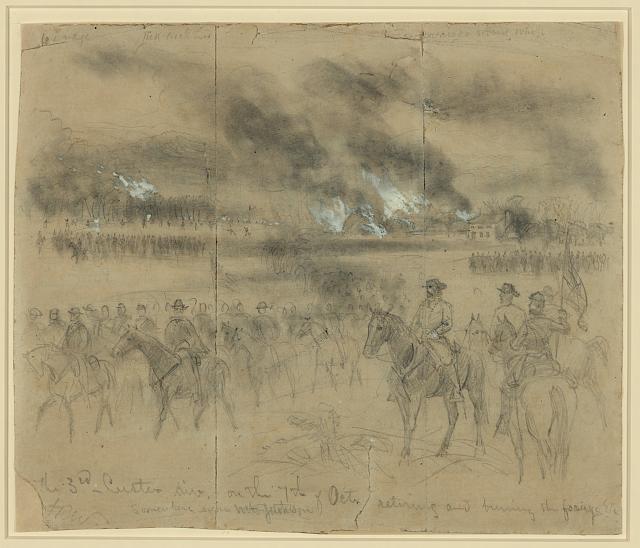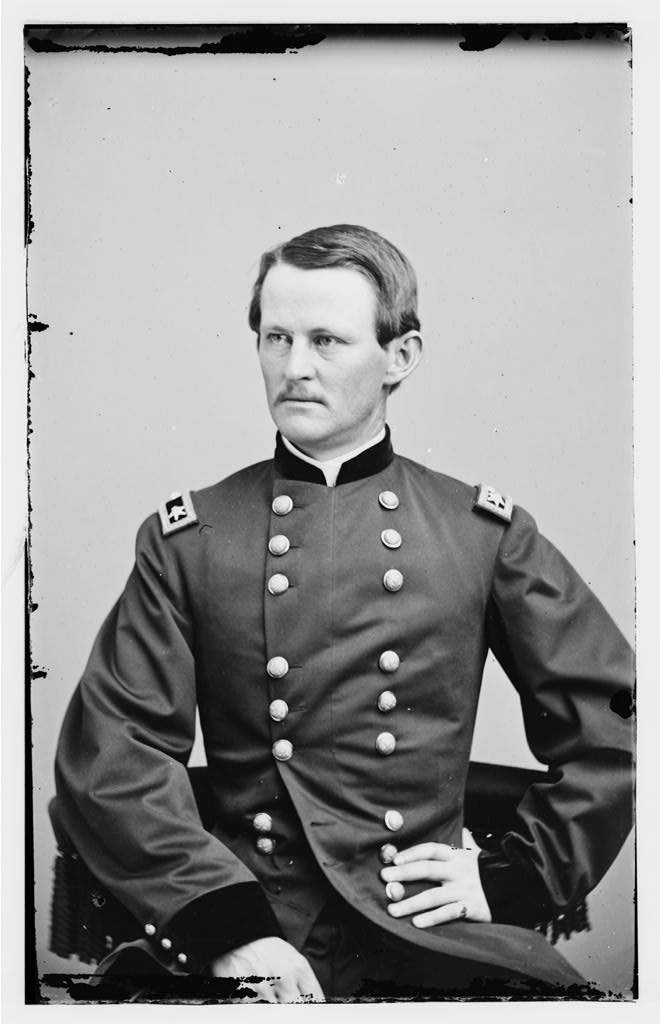Wesley Merritt and the Battle of Tom’s Brook

(courtesy LOC)
Following the Battle of Fisher’s Hill, Maj. Gen. Philip Sheridan’s Federal army pursued Lieut. Gen. Jubal Early’s Rebel forces up the Shenandoah Valley. With the Yankees dogging his march, Early left the Valley, while Sheridan encamped around the town of Harrisonburg, Virginia. There, Sheridan carried out the orders of his superiors and destroyed anything in the surrounding vicinity that could be used to subsist the Confederates. Crops, hay and livestock fell victim to the Yankees. On October 5, Sheridan decided to withdraw down the Valley, destroying everything in his wake. The abandonment of Harrisonburg relinquished the initiative to Early, allowing him to reenter the Shenandoah. Rebel cavalry harassed the rear of the Federal columns. By the late afternoon of October 8, Sheridan was fed up with the annoying Confederates. That night, he ordered his cavalry chief, Maj. Gen. Alfred Torbert to head out in the morning and whip the Rebels “or get whipped yourself”.
The resulting Battle of Tom’s Brook was a decisive Union victory. It was fought on two fronts, along the Back Road (modern 623) and the Valley Turnpike (modern Route 11). Interestingly, it is the fighting that took place between Brig. Gen. George Custer’s Third Cavalry Division and Brig. Gen. Thomas Rosser’s division along the Back Road that is most often remembered about the engagement. This is primarily for two reasons. The section of the battlefield fought over by Rosser and Custer is incredibly well preserved. Aside from a church and a few private houses, the landscape looks much as it did on the day of the battle. Second, the two antagonists, despite the color of the uniform they wore, had been friends since they first met at the U.S. Military Academy at West Point. War could not even tear them apart; after Custer’s controversial death at the Little Big Horn, Rosser was one of the few men who publicly defended his late friend’s actions at that battle.

Overshadowed by Custer and Rosser is the fighting that took place on the Turnpike between the Federal division of Brig. Gen. Wesley Merritt and Confederates led by Brig. Gen. Lunsford Lomax. Merritt, a contemporary of Custer, was born on June 16, 1834 in New York City, but grew up in Illinois. In 1855, he received an appointment to West Point and graduated in the Class of 1860. He would serve briefly in the U.S. Dragoons prior to the war. His first command came as the temporary commander of the Reserve Brigade during the expedition known as Stoneman’s Raid during the Chancellorsville campaign. Distinguishing himself during the raid and the subsequent Battle of Brandy Station, Merritt would be promoted to Brigadier General at the end of June, 1863. Over the course of the next year, Merritt would fight, among other places at Gettysburg, Yellow Tavern and Trevilian’s Station. When Torbert was elevated to command Sheridan’s cavalry, Merritt would take his place at the head of the First Cavalry Division. Once commanded by the superb John Buford, Merritt would play an integral part in Sheridan’s victory at the Battle of Third Winchester, leading his men in a crushing flank attack.
Around 6:30 on the morning of October 9, 1864, Merritt led his division south along the Turnpike to bring the Confederates to battle.Waiting for him was Lomax and his division. Lomax, a Rhode Islander by birth and veteran of the Western Theater, deployed the brigades of Col. Bradley Johnston and Col. William Thompson, on either side of the Valley Turnpike. Merritt’s plan was to use Col. Charles Russell Lowell to strike the Rebels head on, while Col. Thomas Devin’s brigade turned the enemy left. Lomax was initially successful in holding off Lowell. Calling up his old regiment, the 2d Massachusetts Cavalry, Lowell launched a counterattack. Supporting the New Englanders were the 1st New York Dragoons and the 5th U.S. Cavalry. Along with the weight of Devin’s troopers, Lomax’s line gave way. The Rebels withdrew south beyond the village of Woodstock and attempted to re-form. It would be for naught, as the Union troopers crashed into their lines. Lomax’s division crumbled and galloped pell mell in retreat along the Turnpike.
Through the course of the action, Merritt also sent Col. James Kidd’s Michigan Brigade (Custer’s former command) to the aid of their former chief. Custer used Kidd’s men to help drive Rosser’s command from their position along the Back Road. The Confederate collapse on the Back Road, like Lomax’s on the Turnpike quickly escalated into a route. The battle would be forever known as the “Woodstock Races”.
The battle illustrated Merritt’s capacity for command and his ability to direct a battle not only on one front, but in his dispatch of Kidd’s brigade to Custer’s assistance, on two. Not surprisingly, his star continued to rise after Tom’s Brook. He would be the last commander of the cavalry corps of the Army of the Potomac and at Appomattox, he was one of three Federals chosen to formally accept the surrender of the Army of Northern Virginia.
In the post war years, he would command both the 5th U.S. and 9th U.S. Cavalry on the Plains. After many years of dutiful and faithful service, Merritt was promoted to Major General in the U.S. Army in 1895. When war broke out with Spain, Merritt, now sixty-five, commanded the American force that captured Manila. Leaving the army in June, 1900, Merritt spent his time between Washington and Natural Bridge, Virginia. He passed away on December 3, 1910. A cavalryman through and through, Merritt is buried at West Point.
Merritt is one of the great soldiers this country has produced. An outstanding leader.
It seems odd that Merritt’s well deserved promotion to full major general of volunteers was not confirmed by the senate. And he knew nothing about until 1876 when he requestet a duplicate of his “lost” major general’s commission. Another thing, in which year was Merritt born? 1834 (E. J. Warner), 1836 (Don Alberts, Brandy Station to Manila Bay), or 1837 (the latter given by Merritt himself, ACP File, NARA)